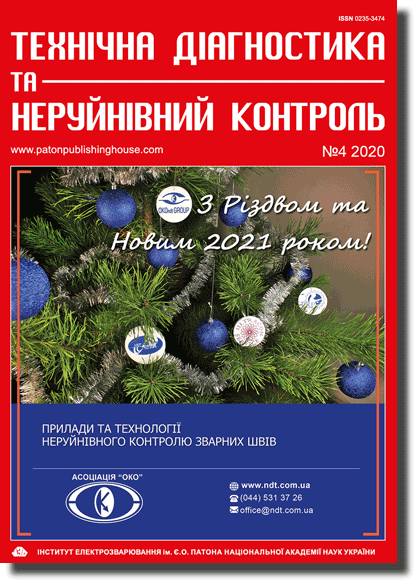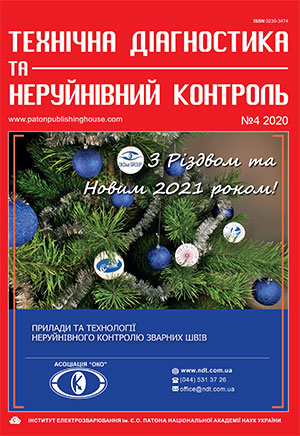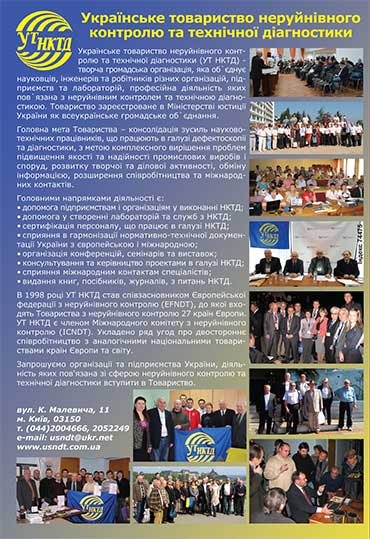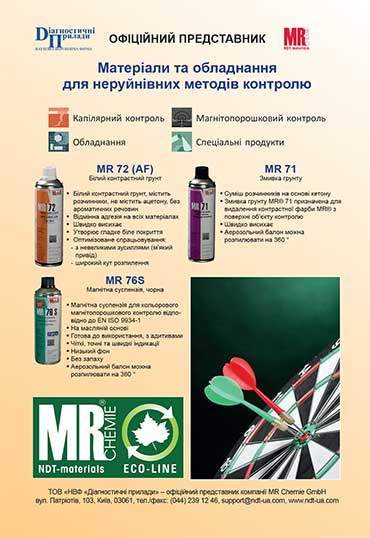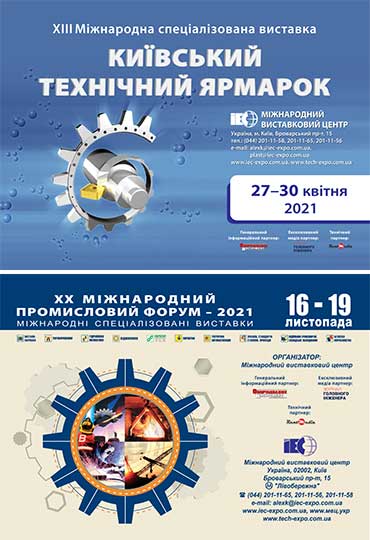| 2020 №04 (08) |
DOI of Article 10.37434/tdnk2020.04.01 |
2020 №04 (02) |
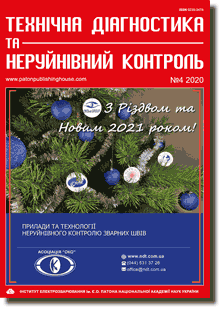
"Tekhnichna Diahnostyka ta Neruinivnyi Kontrol" (Technical Diagnostics and Non-Destructive Testing) #4, 2020, pp. 3-7
Development of the method for assessment of serviceability and residual life of the main pipelines with service macrodelamination
O.T. Tsiryulnik, N.V. Kret, O.I. Zvirko, G.M. Nikiforchin
G.V. Karpenko Physico-Mechanical Institute of NASU. 5 Naukova Str., 79060, Lviv, Ukraine. E-mail: otsyrulnyk@gmail.com
Expert examination of defectiveness of rectangular elbows/bends of pipes in a compressor station of gas transportation systema fter 40 years of operation and of a linear above-ground section of the main gas pipeline-crossing over water obstacles in a mountain area after 30 years of operation was performed by nondestructive method of ultrasonic testing of pipe wall thickness with application of thickness meter with A/B scan MVX (DakotaUltrasonics). A set of diagnostic indications of hydrogen-induced macrodelaminations inside the pipe wall of a main pipeline was complemented by a new diagnostic electrochemical feature, namely polarization resistance. Its lowering by > 30 % allows prediction of such an enhancement of the stress-strain state on the pipe outer surface, which creates a risk of the macrodefect reaching the surface. A method was developed for evaluation of serviceability and residual life of pipes in a system of the main pipelines with service macrodelaminations, which allows for hydrogen role in the processes of development of such a type of macrodefects, service degradation of metal and application of nondestructive testing methods for controlling the level of metal damage inside the pipes. 10 Ref., 1 Table, 6 Fig.
Keywords: service degradation, steels of the main pipelines, diagnostic features of macrodelamination
Received: 09.07.2020
References
1. Baldi, G., Buzzichell, G. (1978) Critical stress for delamination fracture in HSLA steels. Metal Sci., 12, 459-472. https://doi.org/10.1179/0306345787904333322. Bourell, D.L., Sherby O.D. (1983) Texture induced cleavage delamination of warm-rolled low carbon steels. Met. Trans. A., 14A, 12, 2563-2566. https://doi.org/10.1007/BF02668900
3. Kryzhanivskyi, E., Nikiforchin, G., Polutrenko, M. (2013) Corrosion-hydrogen degradation of gas transportation systems and methods of its prevention. In: Proc. of Int. Sci.- Techn. Conf. on Reliability and Effectiveness of Gas Transportation Systems (Yaremche, 2013), 117-128.
4. Tsyrulnyk, O.T., Slobodyan, Z.V., Zvirko, O.I. et al. (2008) Impact of service of X52 steel on corrosion process in a model solution of gas condensate. Fiz.-Khim. Mekhanika Materialiv, 44(5), 29-37 [in Ukrainian]. https://doi.org/10.1007/s11003-009-9138-y
5. Andreikiv, O.E., Gembara, O.V. (2008) Fracture mechanics and fatigue life of metallic materials in hydrogen-containing environments. Kyiv, Naukova Dumka [in Ukrainian].
6. Turnbull, A. (1993) Modeling of environment assisted cracking. Corrosion Sci., 34(6), 921-960. https://doi.org/10.1016/0010-938X(93)90072-O
7. (2007) Specification for line pipe steel API5L, API.
8. SNiP 2.05.06-85. Main pipelines.
9. Crolet, J.L., Maisonneuve, G. (2000) Construction of a universal scale of severity for hydrogen cracking. CORROSION 2000 (26-31 March, Orlando, Florida). Houston TX: NACE International, 2000, Paper 00127.
10. Andreikiv, O.E., Gembara, O.V., Tsyrulnyk, O.T., Nyrkova, L.I. (2012) Evaluation of residual life of a section of the main pipeline «Urengoi-Pomary-Uzhgorod». Fiz.-Khim. Mekhanika Materialiv, 48(2), 103-110 [in Ukrainian]. https://doi.org/10.1007/s11003-012-9497-7
Advertising in this issue:
The cost of subscription/purchase order journals or individual articles
| Journal/Currency | Annual Set | 1 issue printed |
1 issue |
one article |
| TPWJ/USD | 384 $ | 32 $ | 26 $ | 13 $ |
| TPWJ/EUR | 348 € | 29 € | 24 € | 12 € |
| TPWJ/UAH | 7200 UAH | 600 UAH | 600 UAH | 280 UAH |
| AS/UAH | 1800 UAH | 300 UAH | 300 UAH | 150 UAH |
| AS/USD | 192 $ | 32 $ | 26 $ | 13 $ |
| AS/EUR | 180 € | 30 € | 25 € | 12 € |
| SEM/UAH | 1200 UAH | 300 UAH | 300 UAH | 150 UAH |
| SEM/USD | 128 $ | 32 $ | 26 $ | 13 $ |
| SEM/EUR | 120 € | 30 € | 25 € | 12 € |
| TDNK/UAH | 1200 UAH | 300 UAH | 300 UAH | 150 UAH |
| TDNK/USD | 128 $ | 32 $ | 26 $ | 13 $ |
| TDNK/EUR | 120 € | 30 € | 25 € | 15 € |
AS = «Automatic Welding» - 6 issues per year;
TPWJ = «PATON WELDING JOURNAL» - 12 issues per year;
SEM = «Electrometallurgy Today» - 4 issues per year;
TDNK = «Technical Diagnostics and Non-Destructive Testing» - 4 issues per year.





